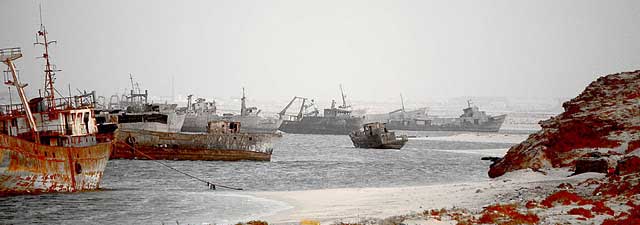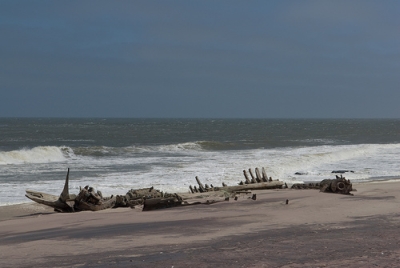
Photo: BBC
Recently the BBC published an article, Nigeria’s coast ‘threatened by shipwrecks’, focused on the 100 rusty shipwrecks which line Nigeria’s 853km (530-mile) coast. The ships are causing coastal erosion and pollution. Nigeria is not the only country on the West coast of Africa with “graveyard of ships” however.
The one of the largest graveyard of ships in the world is in the Bay of Nouadhibou (formerly Port-Étienne.) Nouadhibou is the second largest city in Mauritania. An estimated 300 or more ships have been abandoned. Reportedly the abandonment started in the 80s with the nationalization of the Mauritanian fishing industry, when uneconomical fishing vessels were abandoned in the bay. Foreign owners are said to have seen an opportunity to use the bay as a dumping ground, as well. The bay is now said to have been heavily polluted by the abandoned ships.

Graveyard of ships in the Bay of Nouadhibou
The graveyard of ships on Namibia’s forbidding Skeleton Coast has had a happier outcome. The shipwrecks in this region were generally not dumped by owners but rather were driven ashore by gales or during persistent fogs. The Skeleton Coast and its shipwrecks are now tourist attractions. The government of Namibia has established the Skeleton Coast National Park.

Skeleton Coast
The Skeleton Coast is is normally associated with famous shipwrecks, and stories abound of sailors walking for hundreds of kilometres through this barren Namibian landscape in search of food and water. The name came from the bones that lined the beaches from whaling operations and seal hunts, but more than a few of the skeletons were human. The Bushmen called it The Land God Made in Anger and the Portuguese knew it as The Gates of Hell. Ever since European navigators first discovered it, ships have wrecked on it’s off-shore rocks, or run aground in the blinding fog. While small boats could land, the strong surf made it impossible to launch, hence the stories of sailors walking through the murderous terrain.
The coast has scores of shipwrecks, some are barely recognizable, other are still in remarkably good condition. Perhaps these tragedies were meant to happen, as the wrecks provide excellent environments for Cape fur seals, living side by side with seabird colonies, offering unequaled maritime photographic opportunities.
The Skeleton Coast – Walking Among Shipwrecks

wild!!
Many years ago, upstream from the Niger delta port of Burutu, and on the same island as the port, I saw the wreck of what looked like an old iron sailing ship backed stern first into the mangroves. The bow was clearly visible as was one of the masts also what looked like the remains of a capstan on the bow.
From a small reference book by Robert Jackson entitled “Liners, Tankers and Merchant Ships’, there is a possibility that it could be the ‘Adriatic’ (1856) which is said to have ended its days at Bonny. Could this be one and the same?
Any information on this dilemma would be appreciated.
Pingback: Need for urgent action to curb proliferation of shipwrecks in West Africa with particular reference to Nigeria | Global Maritime Bureau
In my opinion, the appropriate body of the Maritime sector in Nigeria should endeavor to take critical look and immediate action into this hazardous pollution and danger to our coastal waters. Besides a valid data of this shipwrecks should be published of which specialized companies in salvage efforts shall be interested to team with designated government agents/bodies
In response to Hugh Nettleton:
There was an abandoned sailing ship near Burutu called Altair that was built in Liverpool in 1890. She is mentioned in the Historic Ships register.
She is a 4 masted barque with an iron hull, 2400 gross tons.